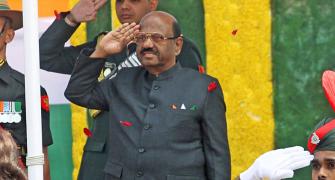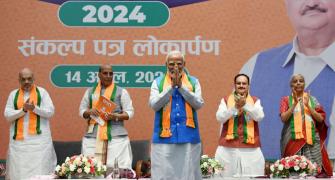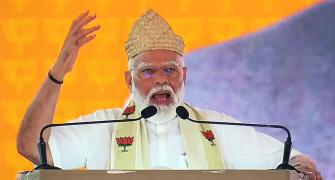There is tremendous demand for fast means of transferring money from abroad by Indians in particular.
According to a Web site called Indianthings.com one of the first questions an Indian asks on reaching the United States is: How do I send money to my parents in India?
This should make every Indian proud. Indians are ranked the largest community pushing even Chinese way down in terms of overseas remittances to homeland.
P Balagopala Kurup, deputy general manager, Indian Overseas Bank, says remittance by an Indian from abroad involves sending money to parents or spouse, repayment of loans, purchase of home, expenses of a marriage, meeting medical expenses, education expenditure of siblings or children. Flow of overseas remittances is largely from the US and the Middle East, he adds.
If a family living in India confronts any emergency situation, and a daughter or a son of the family residing in the US -- or elsewhere -- wants to help by remitting cash immediately, he/she can turn to Western Union Money Transfer.
It is one of the fastest ways of transferring money -- all one has to do is give his or her parent(s) in India a specific code number (unique for each transaction) over the phone. The parents can collect the cash from the nearest Western Union Money Transfer outlet by producing the designated identification code. Once the specific code given by the parent(s) is identified, cash is immediately handed over to them.
However, transferring small sums such as US $100 and $200, this method may prove expensive as the remittance charges will be around $50.
Another limitation of Western Union Money Transfer, particularly for India, is that the country's apex bank, the Reserve Bank of India, permits only 12 transactions a year and total amount for each remittance cannot exceed $2,500.
If there is no great urgency or emergency for remitting the money, then bank cheques are still the favourite of most Indians. The most widely used mode of remittance to India continues to be bank cheques and drafts, Kurup says.
He goes on to further explain that it is usually the sons/daughters working in the US, the UK or elsewhere who remit money to their elderly parents based in India.
Usually, most of these sons/daughters of Indian origin, residing outside on professional grounds, are IT-savvy, but their parents in India commonly prefer cheque transfers rather than a clue in the form of a non-physical code number, as they are more comfortable with the touch and feel of a cheque.
They also are sceptical or apprehensive about the use of online money transfer, as they doubt the security of such a transaction.
In this context, one may opt for another means of money transfer. Most of the public sector banks offer quick delivery of cheque-to-cash conversion.
The parent(s) or the spouse to whom the cheque is remitted may choose to procure cash in just two days for which the bank, in which the cheque is deposited, charges an additional fee. Usually, bank cheques are sent from India to the country where the money is remitted (the US, for example), and there the bank debits the specific account for the sum remitted through inter-bank clearance, which takes its due time.
Yet another mode, which is slowly but surely becoming popular among Indians residing abroad and transferring money to India is online funds transaction. Non-resident Indians can send money to India by the click of a computer mouse.
With Indian banks having partnership with online money transfer services offered by Times of Money, called 'Remit to India', all an NRI needs to do is log on to the website of an Indian bank, which has such a tie-up and also the parents' account with itself.
When he or she logs on, he/she will have to register, get an identification number, choose a mode of payment, send his/her parents the money through a personal check or wire transfer.
At the minimum, the transaction levy is $10 and is a little more for transactions exceeding $2,500. Total monthly remittance in online transfer is limited to $5,000. To get the money credited in the account of an Indian bank, the online money transfers take a minimum of one day and a maximum of two days.
In the money transfer service, called eMoneyTran (started in 2001), the person residing outside India has to: log on to the money transfer site, enter payment details -- including the amount to be sent in US dollar, enter the name and physical mail address of the person to whom he/she intends to send the money, add his/her message to the recipient, and confirm the transaction.
The sender shortly receives an e-mail confirming details of his/her transaction and a tracking number that he/she can use to check the status of the online transaction. Within as little as 48 hours of the transaction, a cheque (payable in rupees) is couriered to the recipient.
Here remember one thing: the best time to complete one's transaction on any business day is before 3 pm (EST). This is one of a few fully online, secure services that allow you to send money using either your credit card, debit card or funds withdrawn directly from your bank account.
As part of eMoneyTran's ongoing verification process and its effort to ensure maximum security for one's account and the accounts that one has debited, eMoneyTran has restricted the total amount of money one can transfer over any given period.
- Generally, one is restricted to the following limits: $2,500 in the first transaction:
- Initial limit of up to $10,000 in the first two months of opening one's account.
- Ongoing limit of up to $40,000 every six months. (Maximum of $7,500 per individual transaction.)








